Jaipur Tour
This famous city is the capital of Rajasthan, which is popularly known as "pink city", founded in 1727 by king sawai Jai singh –II and designed by the brilliant architect Vidyadhar Bhattacharya. The old city is surrounded by a thick wall of 20 ft high and 9ft wide with 8 entrances (Gates). This city has covered the area of about 23 SQ Km. in 1734 the city was named JAIPUR after the king. Today the new city spreds on south–west. But the tourist’s centres are in the old city.
The City Palace

The city palace complex is a Historic Landmark with numerous buildlings, courtyards, impressive gateways and temples. There are 7 gates of this palace houses the seven storied Chandra Mahal. Mubarak Mahal was built by Maharaja Sawai Madho singh II in 1900. Diwan–e-khash meant for special meetings of the officials of Maharaja. Now this is a private Museum of Maharaja and Diwan–e-Aam. The museum displays Mughal and Rajputs weapons, swords of all shapes & sizes. It also has an Art Gallary with a fine collection of paintings, carpets and rare astronomical works.
Janter Manter
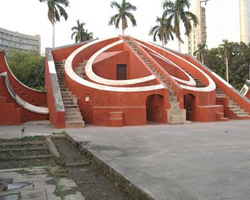
The jantar Mantar is the given to observatories built by Maharaja Sawai jai singh
II of jaipur. While it exists in four cities in all. The sundials at jaipur are
considered to be the most exquisite and mysterious. Jantar comes from yantra or
instrument. and Mantra comes form Mantra or chanting. Which makes the Jantar mantra
a chanting instrument?
For instanceone of instruments is an equinoctial dial, consisting a triangular gnomon
with the hypotenuse parallel to the Earth axis. On the either side of the gnomon
is quadrant of a circle, paralleet to the plane of the equqtor. The instrument intended
to measure the of day, correct to half a second and declination of the sun and the
other hevenly bodies.
Govind Devji Temple
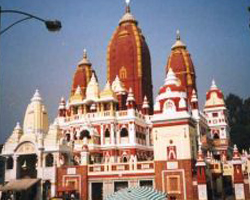
In the central pavilion of the sprawling jai niwas garden to the north of the Chandra Mahal is the temple of lord Krishna. This is most popular temple in the city.
Swargashuli/ Isar lat
The tower dominating the sky line on the western side of Tripolia Bazar is the highest structure in jaipur. It was built by ishar sing in 1749.
Ram Niwas Garden
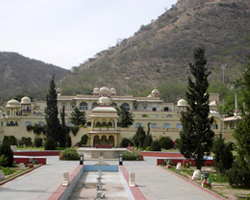
It was set up by maharaja Ram singh in 1817 AD. It houses one of the oldest zoo in the country and Ravindra Rang Manch with a modern Art- Gallery and open air theatre to promote cultural activities.
Doll’s Museum
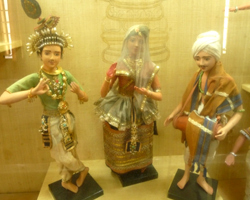
Attractive dolls from various countries are housed in the compound of the school for deaf mute children, near the police Memorial.
Hawa Mahal
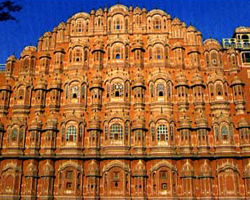
The "palace of winds" is a palace in jaipur. It was built in 1799 by Maharaja Swami
pratap sing, and designed by lal chand ustad. It form part of the city palace and
extends the zenana or women‘s chambers, the harem. Its original intention was to
allow royal ladies to observe everyday life in the street below without being seen.
It has five stories and is constructed of red and pink sand stone, highlighted with
white Quick time. The side facing the street outside the palace complex has 953
small windows, and other breeze (hawa) which circulates through these windows gives
the palace its name, keeps it cool even in hot month.
The entrance opens on to a courtyard with a double storied building on three sides,
and on the eastern wing with three more stories, which is just one room wide. There
are no stairs to reach the upper floor, only ramp.
B.M. Birla Planetarium
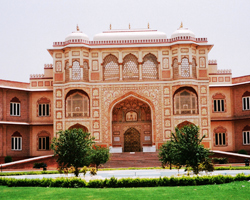
Equipped with modern computerized projection system , the planetarium offer unique audio–visual educational entertainment.
Birla Mandir
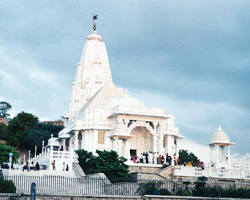
The famous Birla Mandir or The Lakshmi Narayan Temple is situated just below the Moti Dungari .It is a replice of a Scottish castle This temple is one of the most revered Hindu temple, dedicated to Shri Lakshmi Narayan. This is a modern temple built of white marble on top of a hill, dominating the skyline of south Jaipur. The temple has three domes, each portaying the different approaches to religion. The presiding deities here are Vishnu (One of the Hindu Trilogy Gods) called Narayan and his consort Lakshmi Goddess of wealth and good fortune. The temple is built is white marble and exterior has carved sculptures of various mythology cal themes and images of saints. The interior has large panel in marble of mythological proceedings. The images of the deities are placed in the sanctorum.
Galtaji
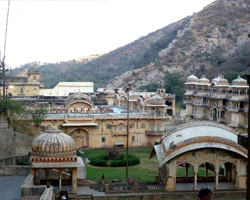
Beyond the gardens amids the low hill guarding the city lies the old pilgrim centre of Galtaji. Temples, pavilions and holdy kunds. The small temple of sun God. Built by Diwan kriparam on the top of the highest peak is visible from the all the parts of the city.
Jain temple
The jain temple on the right side of the Agra road has most beautiful paintings of 19th centuary jaipur style on its inner walls.
Moti Doongri & laksmi Narayan temple
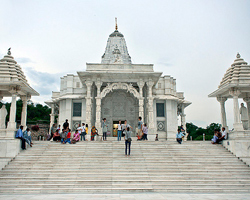
The other important landmarks at the southern horizon are the small privately owned hill top fort of Moti Doongri, Ganesh Temple at the foot of the hill and sparkling white marble Laksmi Narayan Temple built about 10 years ago.
Statue Circle and planetarium
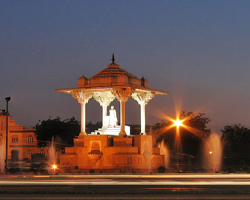
The full length white marble statue of Sawai II installed in the centre of Statue Circle in the newly developed ‘C’ Scheme area was erected as a homage to the founder of jaipur. B.M. Birla planetarium and science are Centre are one of the latest addition in this area.
Gaitore

The cenataphs (Chhatris) of Maharajas of jaipur at Gaitore lie outside the north- east of city under the foot hills of Nahargarh fort.
Amer Tour
For seven long centuries before jaipur was built. Amer served as the capital of the Kachhwaha rulers of the old state of “Dhundhar” . Early structures are now in ruins. It is 13 Km away and on the north-east of jaipur on NH- 8.
Amer palace & Shitla Mata Temple
The complex of places , halls, pavallions, gardens temples were built by Raja Man Singh ,Mirza Raja jai sing and Sawai jai Singh over a period of about two centuries. the image of Shitla Mata was brought from jessore (Bangla Desh) by Raja Man Singh and installed here.
Amer Fort
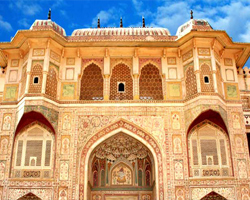
The fort of Amer is located at a distance of 11 kilometers from jaipur and was the
old fort of the Kachhwaha clan of amber, which used to be the capital , till it
was moved to jaipur . The construction of the Amber Fort begin in the year 1592
and was started by Man Singh I, but it was finished by his descendant jai Singh
I . The exterior of the fort is not in the least like its interiors. The outside
is very imposing and rugged looking whereas the inside is a comforting and warm
interior which is influenced by both Hindu and Muslim style of ornamentation.
On the walls, are paintings depicting various hunting scences, and there is also
a lot of work on walls , which are covered with intricate carving , mosaic and minute
mirror work that make the halls looks very majestic and imperial.
Amer fort also called the Amber fort is a must- see if you are visiting Rajasthan
. The tourists to this fort can either approach the fort by road or take an elephant
ride, which though is Quite slow yet is a lot of fun. The fort is built with white
marble and red sandstone and look even more attractive because of the Maota lake
in the foreground .
The fort In itself is a beautiful sight to beautiful sight to behold but as one
looks on the fort with its clear reflection on the lake in the front, one cannot
help but if it is a dream or a beautiful illusion.
Jaigarh Fort

One of the most spectacular Jaigarh fort (Victory Fort) is situated on a hilltop.
One of the few hard-core fortress and military structures of medieval India that
are well preserved and are almost intact, this fort has palaces, granary, well-planned
cannon foundry, several temples, a tall tower and a giant mounted cannon known as
Jaivana, which is believed to be the largest cannon in the world. Built between
15th and 18th centuries, jaigarh Fort is situated 15 km from Jaipur and is surrounded
by forbidding and imposing stone ramparts. The breath taking views form the Dungar
Darwaza, the main gate, are enough to overwhelm anybody who comes to the place.
A collection of coins and puppets are of interest to many collectors. Open to public
now, it has been sealed for seven years by the government to check the authenticity
of the rumor that large amount of gold treasure was buried here, which however never
really found despite all the search of the government officials.
The hug moated fort was built to enforce security of Jaipur and Amber. The armory
and museum within the fort are worth exploring. Though, the palace does not have
the pretty palaces of Amber, it is the perfect place to visit, if you want to see
the full-fledged citadel of ancient India. It takes at least two hours to explore
the vast stretching grounds of the fort. The world’s largest cannon on wheels Jaivana
was constructed in Jaigarh’s foundry in 1720 and its barrel alone weighs close to
50 tons! It is said that it has been fired only once and that its ball fell 35 km
away but this has been found to be untrue and historians believe that it has been
used many times. There are loopholes for guns and boiling oil, a very efficient
system for rainwater harvesting and the photographs of Sawai Bhawani Singh and Major
General Man Singh II, who were senior military officers in the Indian Army, other
Maharajas of Jaipur, palace guards, royal processions and the Jaipur State Cavalry.
At Shubhat Niwas or the meeting Hall of Warriors, one can see a few weather-beaten
sedan chairs and drums.
Nahargarh Fort
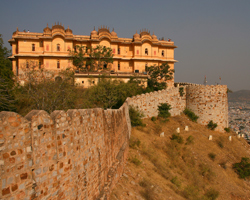
Situated on the rugged ridge of Aravali Hills, Nahargarh Fort is situated to the
north of Jaipur. Floodlit at night, it looks majestic and grand and is a classic
example of fort architecture. Built in 1734 by Sawai Raja Jai Singh II, it was extended
in 1868. The fort is also known as Tiger Fort and was built to further enforcethe
defense of Amber, the erstwhile capital of kachchwahas Rajputs. It has an interesting
legend attached to it. It is said that while the fort was being constructed, everyday
a spirit of a prince known as Nahar Singh a prince would destroy the construction.
To appease the spirit, a tantric was called and it finally agreed to leave on condition
that the fort is named after him. Thus, the fort was named after him.
The erstwhile summer retreat for the royal family, Madhavendra Bhawan was built
by Sawai Ram Singh II. It has a cluster of 12 identical suits for Queens with a
suit for the king at its head, delicate frescos, toilets and kitchen hearths. It
is one of the most favored picnic spot of the region. One can enjoy meals and refreshments
at Durg Cafeteria jand drinks at sunset in the Padao Restaurant on the west. Nahargarh
Fort is the first of the three forts that were built by the kings of Jaipur and
is situated 6 km north west of City Palace. It offers picturesque views of the city
of Jaipur below to the Man Sagar Lake. Ringing with a number of legends, the structures
within the fort are contributed by three kings. The royal retreat for royal queens
and the venue for the shooting parties of the royalty, the palatial duck blind in
the lake was used as a personal treasury for many years. The lovely buildings added
in 19th century, by Swai Ram Singh II and Sawai Madho Singh II, are worth seeing
and are well preserved.
Central Museum (Albert Hall)
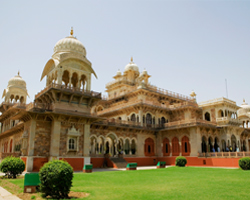
This sandstone and marble building was built in the late 19th century in the Indo-Saracenic
styls. The collection, which unfortunately is not well-maintained or well-organized,
includes folk arts, miniature paintings, traditional costumes, unexpected of yoga
postures, and visual explanations of Indian culture and traditions.
Located just outside the walled city is the sprawling Ram Niwas garden, which has
always been a place for recreational activities since the reign of Sawai Ram Singh
Ji. This exquisitely designed garden with forcentry doors and a huge complex with
small pools and fountains, flourishing lawns and beautiful flower beds all around
was basically a famine relief project. It mostly attracted the British families
where they entertained their guest and families quite often with the lavish gowns
of the Men and formal colourful attires of the nobels and the high society club
members, this park would come alive with the setting sun. Their individual ‘BAGGIS’
were parked outside in a line and the attendants served around as helpers. The children
basically had a gala timely playing around in ‘JHULAS’ (swing) etc. During day time
it was opened for the common public and by the evening it was opened for common
public and by the evening it was available for exclusive lots.
Situated in the middle of the garden as a centre attraction was the exquisitely
built structure of Albert Hall, which was designed by sir Swinton Jacob, a British
architect who designed many palaces in Rajasthan. Combining the elements of English
and north Indian architecture known as the pride of the New Jaipur opened In 1887
AD, it is a very well maintained and impressive building displaying a rich collection
of Art-de-fact like paintings. Carpet, ivory, stone and metal sculptures and colourful
crystal works etc.
Jal Mahal
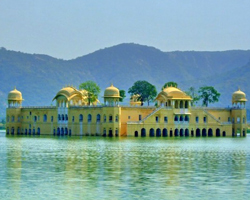
Jal Mahal is an 18th century pleasure palace and is located in Jaipur city of Rajasthan.
The palace is perched amidst Mansagar lake, which is in turn nestled amongst the
Nahargarh hills. The Jal Mahal Palace, Jaipur is noted for its sophisticated design
and grand architecture. The Palace was developed as a pleasure spot and was used
for the royal duck shooting parties. Acauseway leads to Jal Mahal Palace situated
in the middle of Man Sagar lake, opposite the cenotaphs.
The first four floors of this building is under water, only the top floor remains
outside. One can have a wonderful view of the lake and the palace from Nahargarh
Fort Built in 1799, the palace is now abandoned, but reasonably well preserved.
The lake eco system is home to a variety of migratory and resident birds. The Mansagar
Dam on the eastern side of the lake acts as a vantage point for viewing the lake
and the valley.
Excursions
Ramgarh Lake
(32 km north-east) It is famous for its huge artificial lake. A good picnic spot. The temple of Jamna Mata and the ruins of the old fort can be seen here.
Accommodation
Deluxe Hotels: Rambagh Palace, Jai Mahal Palace, Rajputana Palace, Sheraton Hotel Clark, Hotel Man Singh. Hotel Jaipur Ashok, Hotel Jaipur Palace, Holiday Inn etc. Standard Hotels: Narayan Niwas Palace, LMB Hotel, Hotel Aditya, RTDC Hotel Gangaur, Hotel Maru Palace, Hotel Hawa Mahal, Budget Hotels: Hotel Moonlight, Hotel Khasha Koti, Samod Haveli, Hotel Bissau Palace, Broadway, Hotel Mangal, Hotel Teej. Economy Hotels: Arya Niwas, RTDC Hotel Swagatam, Hotel Diggi Palace.
Shopping
A Major Gem & Jewellary Centre. It is famous for Kundan and meenakari work, Woolen Carpets, Cotton Rugs, Marble Statuary, Enamelled & Brassware, Sanganeri Sarees, Bagru cotton fabrics, exotic Blue pottery, Leather footwear etc.





